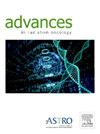Reporting Clinical Results of EPID-Based Patient-Specific Quality Assurance for Brain Stereotactic Radiosurgery/Radiation Therapy: Demonstrating the Feasibility of Same-Day Stereotactic Radiosurgery via HyperArc Delivery
IF 2.7
Q3 ONCOLOGY
引用次数: 0
Abstract
Purpose
Patient-specific quality assurance (PSQA) of complex volumetric modulated arc therapy plans via Electronic portal imaging device (EPID)-based portal dosimetry (PD) is widely adopted by the radiation therapy community. We report our EPID-based PSQA results for brain HyperArc stereotactic radiosurgery/radiation therapy (SRS/SRT) patients, justifying its efficiency for the potential of same-day LINAC-based radiosurgery.
Methods and Materials
A total of 130 brain SRS/SRT patients were treated via highly conformal HyperArc delivery for 1, 3, and 5 fractions of 18–24 Gy, 24–27 Gy, and 30–35 Gy to each lesion in either single-isocenter/single-lesion (SISL, 60 plans) or single-isocenter/multilesion (SIML, 70 plans) setting following the Alliance brain SRS/SRT clinical trial criteria. Acuros-based dose engine for 6MV-FFF beam (1400 MU/min) was used. For each HyperArc SRS/SRT plan, EPID-based PD PSQA was performed. Independent dose verification of these brain SRS/SRT plans was done via an in-house Monte Carlo (MC) program. The PSQA results, total quality assurance (QA) time, MC agreement, and MLC modulation (MF) were analyzed.
Results
The average gamma passing rates were 99.4% (SISL) and 96.9% (SIML) plans with a 2%/2mm clinical gamma criteria. Compared to SISL plans, SIML plans had a higher average MF by a factor of 1.2, maximum of 1.4. We observed a slight correlation between MF and the number of treated lesions. Although SIML plans had relatively lower PSQA pass rates, all plans met the clinical QA criteria for HyperArc delivery. EPID-based PSQA was completed in ∼15 minutes. Moreover, an independent second physics check via in-house MC dose verification was within ±5% compared to AcurosXB calculation and completed within 15 minutes for both treatment schemes including ARIA documentation.
Conclusions
These promising PSQA results for complex clinical HyperArc brain SRS/SRT plans delivered in a timely manner via EPID-based PD and independent MC second check demonstrate EPID-based PD is a fast, safe, and efficient QA method for HyperArc treatments. With proper automation of contouring tool and SRS planning via RapidPlan model, this EPID-based PSQA method can be safely implemented for the same-day HyperArc delivery of high-quality brain SRS/SRT treatments in the near future.
报告基于epid的脑立体定向放射手术/放射治疗患者特异性质量保证的临床结果:通过超弧传递证明当日立体定向放射手术的可行性
目的:基于电子门静脉成像装置(EPID)的门静脉剂量测定(PD)对复杂体积调制弧线治疗方案进行患者特异性质量保证(PSQA)已被放射治疗界广泛采用。我们报告了基于epid的脑超弧立体定向放射手术/放射治疗(SRS/SRT)患者的PSQA结果,证明了其在当日基于linac的放射手术中的潜力。方法和材料根据联盟脑SRS/SRT临床试验标准,对130例脑SRS/SRT患者进行高适形HyperArc递送,分别为18-24 Gy、24-27 Gy和30-35 Gy,分别为1、3和5个分量,单等中心/单病变(SISL, 60个计划)或单等中心/多病变(SIML, 70个计划)。6MV-FFF光束(1400 MU/min)采用acuros剂量机。对于每个HyperArc SRS/SRT计划,进行基于epid的PD PSQA。这些脑SRS/SRT计划的独立剂量验证是通过内部蒙特卡罗(MC)程序完成的。分析PSQA结果、总质量保证(QA)时间、MC一致性和MLC调制(MF)。结果平均伽玛通过率分别为99.4% (SISL)和96.9% (SIML),临床伽玛标准为2%/2mm。与SISL计划相比,SIML计划的平均MF高1.2倍,最大值为1.4倍。我们观察到MF与治疗病灶数量之间有轻微的相关性。尽管SIML计划的PSQA通过率相对较低,但所有计划都符合HyperArc交付的临床QA标准。基于epid的PSQA在约15分钟内完成。此外,与acrosxb计算相比,通过内部MC剂量验证进行的独立第二次物理检查在±5%以内,并且在15分钟内完成两种治疗方案(包括ARIA文件)。结论通过基于epid的PD和独立的MC复核,对临床复杂的HyperArc脑SRS/SRT方案及时交付的PSQA结果表明,基于epid的PD是一种快速、安全、高效的HyperArc治疗QA方法。通过RapidPlan模型实现轮廓工具和SRS规划的适当自动化,这种基于epid的PSQA方法可以在不久的将来安全地实现高质量脑SRS/SRT治疗的当日HyperArc交付。
本文章由计算机程序翻译,如有差异,请以英文原文为准。
求助全文
约1分钟内获得全文
求助全文
来源期刊

Advances in Radiation Oncology
Medicine-Radiology, Nuclear Medicine and Imaging
CiteScore
4.60
自引率
4.30%
发文量
208
审稿时长
98 days
期刊介绍:
The purpose of Advances is to provide information for clinicians who use radiation therapy by publishing: Clinical trial reports and reanalyses. Basic science original reports. Manuscripts examining health services research, comparative and cost effectiveness research, and systematic reviews. Case reports documenting unusual problems and solutions. High quality multi and single institutional series, as well as other novel retrospective hypothesis generating series. Timely critical reviews on important topics in radiation oncology, such as side effects. Articles reporting the natural history of disease and patterns of failure, particularly as they relate to treatment volume delineation. Articles on safety and quality in radiation therapy. Essays on clinical experience. Articles on practice transformation in radiation oncology, in particular: Aspects of health policy that may impact the future practice of radiation oncology. How information technology, such as data analytics and systems innovations, will change radiation oncology practice. Articles on imaging as they relate to radiation therapy treatment.
 求助内容:
求助内容: 应助结果提醒方式:
应助结果提醒方式:


